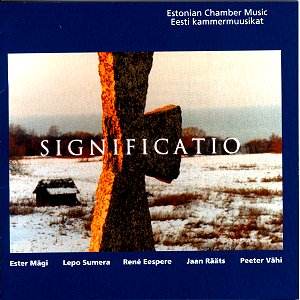This disc has been produced by Estonian Radio for the
Estonian Music Information Centre, and it concentrates mostly on composers
who are important in their own country but whose music has not, as yet,
travelled to Britain or possibly in Europe.
Some Estonian composers have made a name for themselves,
one need only think of Arvo Pärt, or Peteris Vasks or earlier composers
like Kapp and Tubin to realise that in the 20th Century alone
is a vast musical heritage to be shared with the West. I haven’t yet
touched on folk material and 19th Century composers. The
country is, anyway, emerging from a period of artistic suppression and
a figure like Ester Mägi has seen quite a few changes in her lifetime.
She is Estonia’s leading lady composer, and is well represented on this
disc. I had not come across her before nor had I met Vähi, Eespere
and Rääts.
These works are for a rare combination of instruments,
which favours guitar and violin; perhaps a folk-inspired timbre. As
is often the case with any CD of several pieces of new music one warms
to some, but probably not all of the works.
Unfortunately my knowledge of these pieces has to remain
limited as the booklet verges on the useless. There are brief biographies
of each composer, which mentions a few works by each but says nothing
whatsoever about the recorded piece. The performers however have quite
adequate biographies and photographs. The languages are either Estonian
or English. This sort of presentation is clearly not designed with the
international market in mind and for a top price CD the company should
look again at this policy.
Two works set themselves apart for me as well worth
hearing.
Lepo Sumera died last year at barely 50 (the
booklet notes were written before his death.) Amongst his many tasks
he was Chairman of the Estonian Composers’ Association. He wrote four
cantatas, four symphonies, a piano concerto, electro-acoustic music
and some fifty film scores. I listened again to his 3rd Symphony
(BIS-CD-660) and found, as with this piece, a strongly individual voice
writing music of great delicacy, beauty and power. His textures have
a metrical independence as at the start of ‘Odalisque’ which create
a shimmering tonal landscape like no one else. This can be heard also
in the 3rd movement of the 3rd symphony. Sumera
is also fond of monophonic passages orchestrated with varying colours
as in the third of the four Odalisque movements, entitled Sorrowful
Odalisque, and in the symphony’s second movement. The last Odalisque
(called Silent) is a virtuoso exercise for solo flute employing
microtones. This is superbly carried off by Janika Lentsius. This is
a fascinating piece which repays repeat listening.
The other works, which stood out for me, were the two
songs, ‘The Night’ and ‘With eyes closed’ by Ester
Mägi with the marvellous voice of Kaia Urb. The songs are setting
of texts by Viivi Luik. Sadly the texts are not supplied, not even in
Estonian, so I have no idea of their meaning. Nevertheless the music
is idyllic and marvellously lyrical and melancholy, the cello adding
a considerable richness to the texture lacking in the ‘Two Romances’.
The opening work gives the CD its title, and it develops
into an intriguing polyphonic web of violin, cello and guitar after
a gently melodic start. As for the rest of the pieces I would prefer
to draw a discreet veil over them and simply say that another listener
is quite as likely to pick out their own favourites from this enterprising
disc.
The performers are outstanding. In some cases they
make more of the music than it deserves. There is much work for violinist
Urmas Vulp whose perfect intonation, as he negotiates some very challenging
passages, is miraculous. The acoustic is helpful for chamber music,
obviously quite cavernous, but ideal for these combinations where the
guitar is an equal partner with the cello and violin. In the solo guitar
works, played so sensitively by Heiki Matlik, the bass of the instrument
is superbly captured.
Gary Higginson


